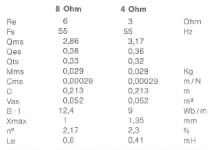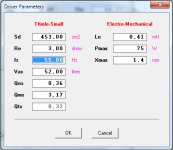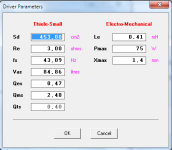Sorry, just tried to be helpful in explaining what max power and max excursion specifications mean.and not a midbass
Anyway, good luck!
The thread is about Hornresp, which is capable of simulating a lot more then just subwoofers.This is a SUBwoofer thread.
For some reason it's placed in the subcategory subwoofers, which is rather confusing. (always has been)
Especially because there has been plenty of other designs been discussed here that are not subwoofer related.
So you can't blame people for using other examples or being confused what type of system is being talked about.
Pmax is usually determined by AES standards with a much broader band noise.
Which unfortunately leads a bit to a chicken-egg discussion in what to expect when a driver is being used <100Hz
That being said, it's wise to let the cone excursion to be the limit of the entire system.
Otherwise you'll leave unused potential on the the table.
On the other hand, if someone has to make-do with what they have, it's what it is.
Btw, a driver will most definitely not always get damaged or even destruct if you go over these limits.
These limits are just "linear limits" (that's even open for debate), but most definitely not maximum mechanical limits.
So PA speakers have a Xlimited that is 2 or 3 times bigger and can handle powers that is 2x/3x times more for short periods of time.
The recommended enclosure SHOULD have an ALL BLACK line in this graph to prevent driver destruction.
I don't see why. Also, how would that be possible if the recommended enclosure is vented? There is no standard that specifies how "manufacturer's recommended enclosures" should be designed, and even if it was, I doubt it would include such a requirement.
Speaking from the experience of having worked for a driver manufacturer, "recommended enclosures" are examples, and mainly designed to give a satisfactory frequency response. Basically an aid for people who just want to buy a driver and stick it in an enclosure to get a working speaker without having to know much about speaker design. It is not typically a design a driver manufacturer would spend lot of time fine-tuning, especially since they don't know the application. It is definitely not the ultimate speaker enclosure for that driver, although the term "recommended enclosure" may lead people to believe that.
What does the response look like if you change the enclosure to satisfy your requirement?
For some reason it's placed in the subcategory subwoofers, which is rather confusing. (always has been)
Especially because there has been plenty of other designs been discussed here that are not subwoofer related.
From the beginning I wanted the Hornresp support thread to be in one of the Loudspeaker forums, rather than in the Software Tools forum.
Loudspeaker forums:
- Multi-Way
- Full Range
- Subwoofers
- Planars & Exotics
The Full Range forum was discounted because Hornresp models the driver diaphragm as a plane circular piston, and therefore cannot accurately simulate a full range loudspeaker.
The Planars & Exotics forum was discounted because Hornresp cannot model such loudspeakers.
This left the Subwoofers forum, which seemed quite appropriate at the time given that Hornresp was originally developed to model bass horn loudspeakers, and because the first message posted to the thread happened to relate to tapped horns.
Part Express does provide a recommended vented enclosure.I don't see why. Also, how would that be possible if the recommended enclosure is vented?
What does the response look like if you change the enclosure to satisfy your requirement?
When I start modeling a driver. I check out how small of a Sealed enclosure the driver can use before I jump to BP4's.
I'm still not understanding Parts Express' recommendation when the driver has a 350wrms rating and 6.8mm Xmax. Excursion at 350wrms is 10.66mm in a 3.75ft3 Sealed enclosure. Those numbers are not logical and seem like a poor recommendation.
Sealed and vented enclosures are not my thing. Low distortion and effortless bass is. I only HEAR those 2 requirements with bandpass enclosures. Plus, I like the built in speaker protection...no grills. I'm not 1 of those people who needs to see the driver.
My best explanation is that Parts Express has prioritized frequency response over driver protection (from full power sine waves at all frequencies).
This is the first time I have seen the requirement that the driver should not be displacement limited at any frequency when driven by sine waves at full electrical power. It's fine if you want to design your enclosures that way, but unless somebody proves otherwise, I think that is very rare among professional speaker designers. And I doubt they would trust a linear model in estimating the excursion at full power anyway.
Another thing to keep in mind, is that the suspension is nonlinear, and may actually limit excursion at full power to less than 10.66mm in this example. But since we don't have the Cms(x) curves, we don't know.
Also, Pmax is long term power, and the driver can usually survive higher short term power. Which also changes the balance between displacement limited and thermal limited max SPL.
Things are not always as simple as we want them to be 🙂
This is the first time I have seen the requirement that the driver should not be displacement limited at any frequency when driven by sine waves at full electrical power. It's fine if you want to design your enclosures that way, but unless somebody proves otherwise, I think that is very rare among professional speaker designers. And I doubt they would trust a linear model in estimating the excursion at full power anyway.
Another thing to keep in mind, is that the suspension is nonlinear, and may actually limit excursion at full power to less than 10.66mm in this example. But since we don't have the Cms(x) curves, we don't know.
Also, Pmax is long term power, and the driver can usually survive higher short term power. Which also changes the balance between displacement limited and thermal limited max SPL.
Things are not always as simple as we want them to be 🙂
Keep in mind that when there is no cone movement, it's also a lot harder to cool down a voice coil.Also, Pmax is long term power, and the driver can usually survive higher short term power. Which also changes the balance between displacement limited and thermal limited max SPL.
Hence the chicken-egg story I was mentioning before.
Hi David, how should I modify this record so it can be successfully imported into Hornresp? It's from a BOXPLAN workbook I'm putting together to help design an 8th order bandpass build.
ID=BOXPLAN
Ang=2.0 x Pi
Eg=28.3
Rg=0.2
Cir=0
Vc1=42.7
Lc1=18
Ap1=211
Lp1=60.1
Vc2=14.6
Lc2=7
Ap2=337.6
Lp2=51.2
Vc3=47.2
Lc3=47.4
Ap3=506.4
S4=0
S5=0
L45=0
F45=0
Sd=220
Bl=16.14
Cms=0.000217
Rms=1.42
Mmd=43
Le=1.7
Re=5.8
Nd=1
Vrc=0
Lrc=0
Fr=0
Tal=0
Vtc=0
Atc=0
Pmax=600
Xmax=7
Path=25.92768
Mass=0
Re'=5.87
Leb=0.61
Le=2.22
Ke=0.18
Rss=57.72
Rms=0
Ams=0
Comment=BOXPLAN-VBSLOT 0.01 - 2024-03-28 12:13:44
ID=BOXPLAN
Ang=2.0 x Pi
Eg=28.3
Rg=0.2
Cir=0
Vc1=42.7
Lc1=18
Ap1=211
Lp1=60.1
Vc2=14.6
Lc2=7
Ap2=337.6
Lp2=51.2
Vc3=47.2
Lc3=47.4
Ap3=506.4
S4=0
S5=0
L45=0
F45=0
Sd=220
Bl=16.14
Cms=0.000217
Rms=1.42
Mmd=43
Le=1.7
Re=5.8
Nd=1
Vrc=0
Lrc=0
Fr=0
Tal=0
Vtc=0
Atc=0
Pmax=600
Xmax=7
Path=25.92768
Mass=0
Re'=5.87
Leb=0.61
Le=2.22
Ke=0.18
Rss=57.72
Rms=0
Ams=0
Comment=BOXPLAN-VBSLOT 0.01 - 2024-03-28 12:13:44
Attachments
This statement is true. Can I add that as you go beyond the voicecoil length within the magnetic gap there is no longer any physical force to push a cone or retract a cone. I know you know this Bjorn, but many people think that more power gets more SPL. Most drivers given a certain enclosure size can be over-driven with relatively less than their maximum rated power. Again many here know this.Also, Pmax is long term power, and the driver can usually survive higher short term power. Which also changes the balance between displacement limited and thermal limited max SPL.
A sealed cabinet is the only type that can be designed that limits the excursion of a driver passively. That's missed by many DIY guys. As is the perception that you have more bass with a bass reflex cabinet. You have a trade. A knee for less low end. The second trade is the ability to shred your driver.
As old man Bp1Fanatic knows very well (same age buddy) A band pass or a true tapped horn, which there are about a dozen designs floating around are very capable of doing.
Fly on the wall over and out.
I'm putting together to help design an 8th order bandpass build.
What do you think Brian?
hello @David McBean
I just saw a strange behavior of the loudspeaker wizard in the TML offset port mode:

when changing to the "power" graph the L34 displays a strange number: multiplied by 10 and without the digit behind the decimal point.
for the rest everything works fine and whenever I change to another graph the number is correct again,
hornresp version 5530-240310
attached my record.
thanks once more for your great tool!
I just saw a strange behavior of the loudspeaker wizard in the TML offset port mode:
when changing to the "power" graph the L34 displays a strange number: multiplied by 10 and without the digit behind the decimal point.
for the rest everything works fine and whenever I change to another graph the number is correct again,
hornresp version 5530-240310
attached my record.
thanks once more for your great tool!
Attachments
Hi David, how should I modify this record so it can be successfully imported into Hornresp?
Hi Brian,
Required modifications:
1. Assuming that the port 3 tube length is 40 cm, insert the statement line Lp3=40 between statement lines Ap3=506.4 and S4=0.
2. Change the statement line Nd=1 to BP8S=1 for a BP8 series configuration, or BP8P=1 for a BP8 parallel configuration.
The attached BOXPLAN.TXT file contains the above changes and should import correctly into Hornresp as an eighth order parallel bandpass enclosure loudspeaker.
Kind regards,
David
Attachments
I just saw a strange behavior of the loudspeaker wizard in the TML offset port mode:
Hi stv,
Many thanks for the feedback. The bug will be fixed in the next update.
Kind regards,
David
Hornresp Update 5530-240329
Hi Everyone,
BUG FIX
The bug reported in Post #14,532 has now been fixed.
My thanks to stv for making me aware of the problem.
Kind regards,
David
Hi Everyone,
BUG FIX
The bug reported in Post #14,532 has now been fixed.
My thanks to stv for making me aware of the problem.
Kind regards,
David
Thanks David, those changes made the difference. Hornresp can now read the exported sims from my 8th order BP BOXPLAN sheet.Hi Brian,
Required modifications:
1. Assuming that the port 3 tube length is 40 cm, insert the statement line Lp3=40 between statement lines Ap3=506.4 and S4=0.
2. Change the statement line Nd=1 to BP8S=1 for a BP8 series configuration, or BP8P=1 for a BP8 parallel configuration.
The attached BOXPLAN.TXT file contains the above changes and should import correctly into Hornresp as an eighth order parallel bandpass enclosure loudspeaker.
Kind regards,
David
I think you're probably going to have a challenge fitting the drivers and the vents into a box with those required chamber sizes ...
I suck at designing 8th order boxes. They take me forever. This should be interesting to try out. Thanks Brian!
You're not the only one, LOL. Since putting the workbook together, I've been trying to find a driver that the corresponding sims suggest would be a good match for the alignment, and I'm coming up blank. For decent bandwidth, going by the Bose AM5 driver specs, you need to find a driver with Q around 0.3, Fs about 1.3*Fb, Vas = 0.08*Sd (double that if looking at a single-driver solution) and a decent Xmax for bass duty.
The next update I'm going to be working on for the workbook is to allow for dual-driver alignments, and then try using it to model something like the AM5 Series II bass module (I have access to the bass drivers used in that module).
The next update I'm going to be working on for the workbook is to allow for dual-driver alignments, and then try using it to model something like the AM5 Series II bass module (I have access to the bass drivers used in that module).
I am experiencing inconsistencies between the driver manufactures T/S parameters and what I can actually input in Hornresp.
Attachment 1 is a screenshot of the T/S parameters according to the manufacturer (4Ohm driver).
I Double Click on SD, and fill out the "driver parameters" pop up window (attachment 2)
CMS and BL are then automatically calculated but they don't match with BL and CMS figures according to the manufacturer.
Infact BL is 11.64 when it should be 9, and CMS is 1,78E-04 when it should be 2.90E-04.
If I input the BL and CMS figures from the manufacturer's (BL=9 and CMS=0,00029) all the rest of the driver paramaters are automatically updated and no longer match the manufacturer's (attachment3).
In other words, the BL and CMS figures as per the manufacturer's specs do not appear to be compatible with the rest of the driver's parameters.
This issue bothers me because it has a remarkable effect on the power response simulation.
I dont know which of the two simulations should be considered valid, the one where the BL and CMS are automatically calculated or the one after replacing those values with those provided by the manufacturer.
Attachment 1 is a screenshot of the T/S parameters according to the manufacturer (4Ohm driver).
I Double Click on SD, and fill out the "driver parameters" pop up window (attachment 2)
CMS and BL are then automatically calculated but they don't match with BL and CMS figures according to the manufacturer.
Infact BL is 11.64 when it should be 9, and CMS is 1,78E-04 when it should be 2.90E-04.
If I input the BL and CMS figures from the manufacturer's (BL=9 and CMS=0,00029) all the rest of the driver paramaters are automatically updated and no longer match the manufacturer's (attachment3).
In other words, the BL and CMS figures as per the manufacturer's specs do not appear to be compatible with the rest of the driver's parameters.
This issue bothers me because it has a remarkable effect on the power response simulation.
I dont know which of the two simulations should be considered valid, the one where the BL and CMS are automatically calculated or the one after replacing those values with those provided by the manufacturer.
Attachments
- Home
- Loudspeakers
- Subwoofers
- Hornresp


